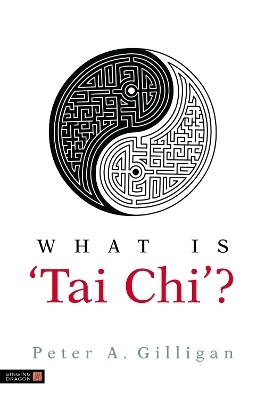
What is 'Tai Chi'?
Singing Dragon (Verlag)
978-1-84819-024-5 (ISBN)
This book grew out of a question one of the author's students asked. The answer proved to be longer than either teacher or student could have anticipated.
As he looks at the complex art of 'Tai Chi', the author answers questions such as why, unlike in other martial arts, 'Tai Chi' has no gradings; how hard you should try; and how to make the most of your teacher. A wide range of material is covered, including fundamental points about the mechanics of movement and the 'energetic' aspects of practice, as well as the relationship between body, mind and spirit that emerges. The author also provides answers to questions that even experienced practitioners may not have thought to ask, such as what are the levels of self-defense in 'Tai Chi'? How do I refine and develop my 'Tai Chi'? What is the difference between method and technique? How do I put principles into practice?
This insightful book covers all aspects of 'Tai Chi', answering questions that are beyond the scope of many classes. It will be of interest to anyone beginning 'Tai Chi' or Qi Gong, as well as to more experienced practitioners at all levels, practitioners of other martial arts, and friends and relatives of "Tai Chi" players who wonder what all the fuss and enthusiasm is about.
Peter Gilligan had over thirty years' experience of Tai Chi, Qi gong and the Nei Jia (internal arts).He also had extensive experience as an Outdoor Pursuits Instructor and as an Associate Research Assistant at the Ergonomics unit of University College London. This, coupled with three months study of the therapeutic applications of Qigong and Taijiquan within the Chinese National Health Service, made him uniquely qualified to relate the art of Taijiquan to both Western scientific method and physical culture and education. Peter was a registered instructor with the British Council for Chinese Martial Arts, and he was founder and director of the DAH School of Chinese Internal Arts, the only full-time school of its kind in Belfast.
Acknowledgements. A Note on Romanisation. Section 1. Preliminaries and Preconceptions. 1. A Punet of Problems. Introduction. The Problems of Gradings. The Problem of Cultural Communication. The Problem of Language. The Need for Contextual Study. The Systems Approach. The Basic Chinese World View. Conclusion. 2. What's in a Word? Preliminaries: Background, Chinese Terms, What is Taijiquan? Taijiquan as Self Cultivation. Cultivation. Qi. Yin-Yang. Qi Gong. Schools of Qi Gong: Internal and External. The Use of Sensitivity. The Use of Intention (Will/Imagination). The Three Systems of Qi Gong. Types of Qigong. Jing Gong. Jing - Dong Gong. Dong Gong. Use of Xin (Sensitivity) and Yi (Will) in Qi Gong. Summary. 3. Laying the Martial Ghost. Taijiquan as Self Defense. Self Defense and Martial Art. Wu and Martial are not the Same. Martial Art and Wu Shu. Wu Shu, Gong Fu and Self-Cultivation. Taijiquan as Wu Shu. Three Levels of Testing in Taijiquan. The Role of 'Sparring' in Taijiquan. A Taijiquan Approach to Wu Shu. A Personal Encounter. Conclusion. Section 2. Initial Foundation. 4. Returning to Nature, Restoring Spring. The Meaning of Natural in Taijiquan. The Rectification of the Body. The Need for a Teacher. The Rectified Body. The Rectified Body: No Blocking or Wasting. Natural Alignment. Structure and Posture. The Application of Yin-Yang to the Body. Conclusion. 5. Learning How to Learn. Don't Try Too Hard. Should is a Condition – Not a Command. Wei Wu-Wei. Song. Song is the Expression of Taiji in the Body. Testing. Methods of Testing. Testing Song. Making the Most of Your Teacher. Summary. Basic Standing Posture. Three Circle Theory. 6. Methods and Techniques. Taiji and Taijiquan are not the Same. Daoyin. What are Methods and Techniques. People are Individuals, Unique and Different. Daoyin is Qi Gong. Daoyin and Gong Fu; Internal and External. Daoyin in Taijiquan. An Exercise to Learn Daoyin. The Three Systems of Daoyin Qi Gong. Conclusion. Section 3. The Art of Taijiquan. 7. The Six Secrets. The Six Secrets. Nei Gong. The Six Secrets as Nei Gong. Discussion of the Six Secrets. Three-Circle Theory. Yin Yang Theory. Taijiquan Forms are Movements. Benefits of Yin-Yang Form Study. Stages of Yin Yang Study. Spiral, or Qi, Form. Problems in Spiral Form Study. Centre-Turn Form. Spiral in the Leg. Yin-Yang Head and Hands. Conclusion. 8. Practice to Perfection. The Syllabus of Taijiquan. The Taijiquan Teacher's Job. Practicing Taijiquan. Syllabus, Technique and Method. Internal Breathing; Nei Gong. Nei Gong Daoyin Exercise. Testing and Warnings. Traditional Nei Gong. Conclusion. Appendix. Taijiquan: Forms, Techniques and Practices. Supplementary Forms and Practices. Pushing Hands. Two Person Taijiquan. Weapons Forms. References. Bibliography.
| Erscheint lt. Verlag | 15.11.2009 |
|---|---|
| Zusatzinfo | 27 line drawings and 28 photographs |
| Verlagsort | London |
| Sprache | englisch |
| Maße | 157 x 233 mm |
| Gewicht | 348 g |
| Themenwelt | Sachbuch/Ratgeber ► Sport ► Kampfsport / Selbstverteidigung |
| ISBN-10 | 1-84819-024-7 / 1848190247 |
| ISBN-13 | 978-1-84819-024-5 / 9781848190245 |
| Zustand | Neuware |
| Informationen gemäß Produktsicherheitsverordnung (GPSR) | |
| Haben Sie eine Frage zum Produkt? |
aus dem Bereich


